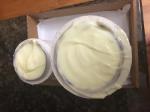Coconut Oil Soap Seized
This is my first time making 100% coconut oil soap and when I mixed the lye water mix to the coconut oil it started to thicken very quickly.
I hand wisked it for about 10 seconds and saw that it was like thick pudding. Afraid that it did not mix well, I stick blended to a stand still. Then just scooped it into the mold 15 minutes or less it stated to gel with no insulation.
While scooping it into the mold, I noticed liquids here and there, it was thick mash potato by the time I stuffed it into a mold, plenty of air pockets in there too I am sure.
SO could someone please tell me if this soap is any good or what can I do with it PLEASE.
I had the 5lb coconut oil at room temperature and the lye water mixture sat for about an hour before I mixed it, It felt hot, not warm, to the touch.
Answer:
The room temperature method requires that the lye water be poured onto the hard oils as soon as the crystals have dissolved. This ensures that the hard oils completely melt.
I'm not sure that I would attempt to use the room temperature method on a batch that was using only hard oils either. Definitely a situation where an ultra fast trace will occur.
I would also check your recipe to make sure the right amount of lye was used. The lye water should not still be hot after a whole hour.
The only way to tell if the soap is okay is to test it. Some people put the tip of their tongue on the soap and if it zaps like a nine volt battery, it may be lye heavy, especially if a week or so has passed. I personally am not a fan of putting my tongue on the soap so I would use pH strips to check the pH level. The soap should be between 7 and 10.
Cathy
Comments for Coconut Oil Soap Seized
|
||
|
||
|
||
|
||

